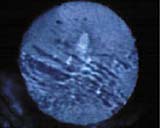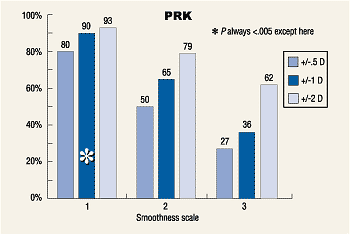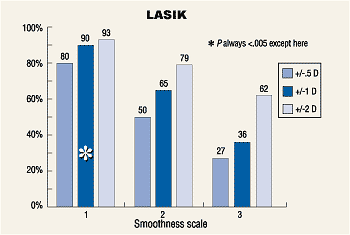Smooth the surface for better results
Irregularities on the surface affect visual results both in PRK and LASIK and always should be eliminated.
VENICE, Italy — Smoothing is of crucial importance in optimizing visual results after laser photoablation, according to a study by Severino Fruscella, MD, and Paolo Vinciguerra, MD, presented at the Venice 2000 meeting.
 ---Figure 1:
Digitized retroillumination image of the cornea after a LASIK
procedure, with perfectly regular ablated surface — smoothness scale
1.
---Figure 1:
Digitized retroillumination image of the cornea after a LASIK
procedure, with perfectly regular ablated surface — smoothness scale
1.
“Surface irregularities produce many undesirable effects both in photorefractive keratectomy [PRK] and laser in situ keratomileusis [LASIK]. In PRK, they might be the cause of delayed re-epithelialization, pain, late functional recovery, haze and regression. In LASIK, they affect the regularity and smoothness of the interface, causing light diffraction and reduction of contrast sensitivity,” Dr. Fruscella said.
The quality of the surface depends on a variety of factors: the ablation system; the type, model and setting of the laser; and the eye movements of the patient. A study recently published in the Journal of Refractive Surgery showed how a standard treatment simulated on a PMMA surface at different times, with different lasers of the same model and manufacturer, produced different ablated surfaces each time.
“You can never entirely predict what your results will be,” Dr. Fruscella said. “On average, however, the surfaces presenting some irregularities result in smoother surfaces after the smoothing procedure.”
Grading surface quality
 ---Figure 2: Digitized retroillumination image
showing ablation irregularities after PRK, more evident inferiorly
— smoothness scale 2.
---Figure 2: Digitized retroillumination image
showing ablation irregularities after PRK, more evident inferiorly
— smoothness scale 2.
With digitized retroillumination (a system devised by Dr. Vinciguerra some years ago), the quality of the surface can be explored under high magnification. A three-scale classification (Vinciguerra scale) can then be used to divide surfaces into three groups: “very smooth” (scale 1), “moderately irregular” (scale 2) and “very irregular” (scale 3); (Figures 1, 2, 3).
In a preliminary study, a number of PRK and LASIK patients were classified into the three groups and their distance from emmetropia was compared. Scale 1 patients were shown to be much nearer to emmetropic values.
Haze after PRK also was evaluated at 12 months. Scale 1 patients had no or little haze, and scale 3 patients had the highest degree of haze.
Smoothing makes the difference
 ---Figure 3: Digitized retroillumination image
showing marked ablation irregularities after a LASIK procedure, with pronounced
impairment of the corneal optical quality — smoothness scale 3.
---Figure 3: Digitized retroillumination image
showing marked ablation irregularities after a LASIK procedure, with pronounced
impairment of the corneal optical quality — smoothness scale 3.
“In a more recent study, 225 PRK and LASIK eyes were graded according to our smoothness scale,” Dr. Fruscella said. “In 78 eyes, the surface was perfectly smooth (scale 1), in 91 eyes it presented some irregularities (scale 2) and in 56 eyes it was very irregular (scale 3). Scale 2 and scale 3 patients were randomized into two groups. The 74 eyes of group 1 had smoothing of the surface immediately after laser ablation, whereas the 73 eyes of group 2 were patched without additional treatment.”
Visual results were then compared. The patients who had smoothing were considerably nearer to emmetropia and had a better spectacle corrected visual acuity.
For the smoothing procedure, Dr. Fruscella and Dr. Vinciguerra use a Nidek (Fremont, U.S.A.) EC-5000 laser set at 10 Hz.
A variable number of 30 to 50 scannings are performed. Corneas are prepared with masking fluid (sodium hyaluronate 0.25%). The fluid is spatulated to form a thin layer on the cornea. The surface quality is then tested with high magnification.
“Smoothing is a simple technique that can really make the difference in terms of visual results and general eye comfort. Also, the less experienced surgeons can do it without problems and with advantages,” Dr. Fruscella said.
Venice 2000 was sponsored by Ocular Surgery News, the Italian Association of Cataract and Refractive Surgery and the International Society of Refractive Surgery.
Difference from emmetropia at 12 |
|
 |
|
 |
For Your Information:
- Severino Fruscella, MD, can be reached at Piazza della Marina 9, 00196 Rome, Italy; +(39) 06-3201504; fax: +(39) 06-3201258; e-mail: fruscella@uni.net. Dr. Fruscella has no direct financial interest in any of the products mentioned in this article, nor is he a paid consultant for any companies mentioned.
- Paolo Vinciguerra, MD, can be reached at Via Ripamonti 205, Milan, 20141, Italy; +(39) 02-55211388; fax: +(39) 02-57410355; Dr. Vinciguerra has no direct financial interest in any of the products mentioned in this article. He is a paid consultant for Nidek.
